
| |
|
|
|
|
For media enquiries please contact James Rickards on |
|
|
Tel: 61 2 8274 5304 Mob: 0419 731 371. For |
|
|
investor/analyst enquiries please contact Steve Ashe on |
|
|
Tel: 61 2 8274 5246 or Mob: 0408 164 011 |
21 December 2004
James Hardie signs Heads of Agreement
James Hardie Industries NV (JHINV) today announced it had signed a Heads of Agreement with the
Australian Council of Trade Unions (ACTU), Unions New South Wales, asbestos support groups and the
New South Wales Government, to provide long-term funding of asbestos related personal injury claims
against former JHINV companies. James Hardie made a voluntary funding proposal to the Jackson
Commission in July 2004 and is pleased to have now reached agreement on the principles on which
James Hardie will provide voluntary funding. These include:
| |
• |
|
the establishment of a Special Purpose Fund (SPF) to compensate asbestos victims; |
| |
| |
• |
|
initial funding of the SPF by James Hardie on the basis of the November 2004 KPMG
Actuaries’ report (which provided a net present value central estimate of $1.5 billion in
present and future claims at 30 June 2004). The actuarial assessment is to be updated
annually; |
| |
| |
• |
|
a two year rolling cash ‘buffer’ in the SPF and an annual contribution in advance based
on actuarial assessments of expected claims for the next three years, revised annually; |
| |
| |
• |
|
a cap on the annual James Hardie payments to the SPF, initially set at 35% of annual net
operating cash flow of the JHINV Group for the immediately preceding financial year, with
provision for the percentage to decline over time depending on James Hardie’s financial
performance and the claims outlook; and |
| |
| |
• |
|
no cap on individual payments to proven claimants. |
The Heads of Agreement will form the basis of a Principal Agreement to be settled between JHINV and
the NSW Government which, in turn, will require the support of JHINV’s lenders and shareholders.
The Principal Agreement is to be a legally binding agreement.
Based on KPMG Actuaries’ assessment and expectations of James Hardie’s future financial
performance, the arrangement is intended to allow payments to be made by the SPF to all future
proven claimants against the former James Hardie subsidiaries for asbestos-related diseases.
However, it should be recognised that because the number of claimants and the amounts that the
courts may award is uncertain and James Hardie may not perform as currently projected, no absolute
assurance on this can be given.
James Hardie has already paid out some A$450 million in asbestos compensation. No legitimate
claimant to date has gone unpaid.
JHINV Chairman Meredith Hellicar said: “The ACTU, NSW Government and asbestos support groups have
worked with James Hardie to reach an agreement which we believe is in the best interests of
claimants, shareholders, employees and all other stakeholders.
“All parties involved in the recent negotiations have agreed it is in the interests of asbestos
claimants that James Hardie is, and remains, financially strong and able to continue to fund its
growth. The proposed funding arrangements allow this and James Hardie will be able to continue to
successfully grow its business.”
Ms Hellicar said the agreement was an important first step towards rebuilding the reputation of
James Hardie over the coming months and years.
“I regret any stress caused to asbestos disease sufferers and their families by the
unintentional funding shortfall of the MRCF, and hope that this announcement will ease the concern
of those sufferers and their families.
“I also commit myself to the task of rebuilding the reputation of James Hardie over the coming
months and years for the sake of our many employees, customers, shareholders and other
stakeholders.
“This agreement follows the original intention of the Board of James Hardie in setting up the
Medical Research and Compensation Foundation (MRCF) to properly fund the MRCF. It is expected to
provide claimants and their families with assurance that their claims will be met, based on all of
the data and estimates available to us.
“It is an historic agreement and our commitment reflects the fact — corroborated by the findings of
Commissioner Jackson — that James Hardie did not restructure its affairs nor move to the
Netherlands to avoid liability for asbestos claims. The Board is pleased with this agreement and
looks forward to finalising the Principal Agreement and taking it to our lenders and shareholders
for their consideration.”
Ms Hellicar said that the company and the NSW Government will now move to settle the terms of the
Principal Agreement whilst waiting on the outcome of the NSW Government’s Review of Legal and
Administrative Costs in Dust Diseases Compensation Claims. This Review is expected to have a
significant impact on the financial strength of the proposed Special Purpose Fund and the
affordability and sustainability of James Hardie’s funding proposal.
End
A briefing on the Heads of Agreement follows.
2
Heads of Agreement — Briefing
This document provides key facts about the Heads of Agreement reached between James Hardie
Industries NV (JHINV), The Australian Council of Trade Unions (ACTU), Unions New South Wales,
asbestos support groups and the New South Wales Government.
Before the funding arrangement can be finalised, the NSW Government Review of Legal and
Administrative Costs in Dust Diseases Compensation Claims (announced on 18 November 2004) will need
to be completed and considered and any resulting reforms adopted. James Hardie will need lender and
shareholder approval of the funding arrangement.
Key Principles
The two key principles underlying the Heads of Agreement are:
| |
1) |
|
James Hardie will provide funding on a long-term basis to a Special Purpose Fund which
will be applied to paying proven claims now and into the future, and in dealing with
claims; and |
| |
| |
2) |
|
That to achieve this, James Hardie has to remain profitable and strong and be able to
continue to successfully grow its business. |
The Heads of Agreement includes the following key financial terms:
Special Purpose Fund
| • |
|
A Special Purpose Fund (SPF) will be created to
compensate proven asbestos claimants. A majority of
directors of the SPF will be appointed by James Hardie. |
Annual Actuarial Assessment
| • |
|
There will be an annual actuarial assessment of the
liabilities of the SPF in order to take into account the
uncertainties associated with actuaries’ projections.
This will enable the projections to be regularly updated
in line with the actual claims experience and claims
outlook. |
| • |
|
Subject to the Annual Cash Flow Cap described below,
James Hardie will make contributions to the SPF based on
these annual actuarial assessments. |
Buffer
| • |
|
Subject to the Annual Cash Flow Cap described below, at
the start of each year James Hardie will ensure that the
SPF has a two-year rolling cash “buffer” and one year’s
contribution based on the annual actuarial assessment of
expected claims for the next three years. |
| • |
|
Assuming legal costs as a percentage of compensation paid
to claimants (currently running at approximately 36%)
fall to 20% over a three year period, the initial three
year amount is expected to be $239 million (based on KPMG
Actuaries’ estimate of liabilities as at 30 June 2004).
The contribution by James Hardie in the year ending 31
March 2006 will be reduced by assets to be contributed by
the Medical Research and Compensation Foundation which
are expected to be approximately $125 million. As
anticipated payments during the first three years of the
SPF are expected to exceed the Annual Cash Flow Cap
described below, James Hardie |
3
| |
|
expects to make an additional net payment of approximately $22 million in the year ending 31
March 2006 to cover the period to 31 March 2008. |
| • |
|
This means that (subject to the Annual Cash Flow
Cap) there should be a maximum of three years’
funding available in the SPF at the start of
each year which, during the course of the year,
should reduce to an estimated two years of
funding as claims are recognised and paid out.
The funding will then be topped up by James
Hardie (subject to the operation of the Annual
Cash Flow Cap) at the start of the next year so
that it again represents three years of
projected claims based on the then current
annual actuarial assessment. This dynamic
structure should provide greater security to
present and future claimants as the SPF should
be better able to reflect changes in the
incidence of claims and/or changes in the
financial performance of James Hardie. |
Annual Cash Flow Cap
| • |
|
There will be a Cash Flow Percentage Cap
(“CFPC”) on the annual James Hardie payments to
the SPF in all years except the first year. It
is not intended that there will be any caps on
payments by the SPF to individual claimants.
The CFPC will be initially set at 35% of James
Hardie’s net operating cash flow for the
immediate preceding financial year. Net
operating cash flow for the purposes of the cap
will be equivalent to James Hardie’s cash flow
provided by operating activities as set out in
its audited accounts and will therefore be after
taxes, interest, changes in working capital and
asbestos claims payments. |
| • |
|
The 35% level is designed to ensure that all
proven claimants can be paid whilst preserving
the financial health and growth prospects of
James Hardie. All parties recognise that James
Hardie’s continuing success is crucial to the
long term security of the future payments.
However, because the number of claimants and the
amounts that the courts may award is uncertain
and James Hardie may not perform as currently
projected, no absolute assurance on this can be
given. |
Changes in the level of Annual Cash Flow Cap
| • |
|
After the year ending 31 March 2011, the Heads
of Agreement provides that the CFPC may reduce
in increments of 5% (to a floor of 10%),
provided that the annual contributions are, on
average, lower than the reduced CFPC level for
the four years preceding the reduction, and that
the CFPC cannot reduce by more than 5% in any
four year period. There is also provision for
the CFPC to increase in certain circumstances,
although never above 35% and never by more than
one increase of 5% above a previously reduced
cap level. |
| • |
|
The practical impact of the above cap, and
conditions for changes in the level of the cap,
is that the earliest that the CFPC could step
down would be to 30% in the year ending 31 March
2012, to 25% for 2016, to 20% for 2020, to 15%
for 2024 and to 10% for 2028 depending on the
claims experience, anticipated claims payments
and the financial performance of James Hardie. |
| • |
|
Based on current actuarial estimates (KPMG
Actuaries’ central estimate of liabilities of
$1.5 billion as at June 30 2004) and
expectations of James Hardie’s future financial
performance, the proposed caps are intended to
allow payments to claimants to be properly
funded and to have the benefit of a significant
contingency provision. |
4
Legal Costs
All parties to the negotiations recognise the importance of achieving substantial legal and
administrative cost savings in the claims management process in order to improve the financial
position of the SPF, and therefore the security of future claimants, over the long-term.
Legal and administrative costs incurred in asbestos claims against the former James Hardie
companies now owned by the MRCF have an estimated net present value of approximately $410 million.
This high level of costs (equivalent to 36% of payments projected to be paid to claimants by the
SPF) has a major adverse effect on the long-term strength of any funding proposal over the lengthy
time period proposed by James Hardie (at least 40 years but potentially as long as 70 years).
The expected claims (net of insurance and other recoveries) based on the KPMG Actuaries’ report as
at 30 June 2004 are set out below, together with the expected net claims assuming that legal costs
as a percentage of compensation paid to claimants is reduced from their extraordinarily high
current level of 36% to 27.5%, 20% and 12.5% per cent respectively.
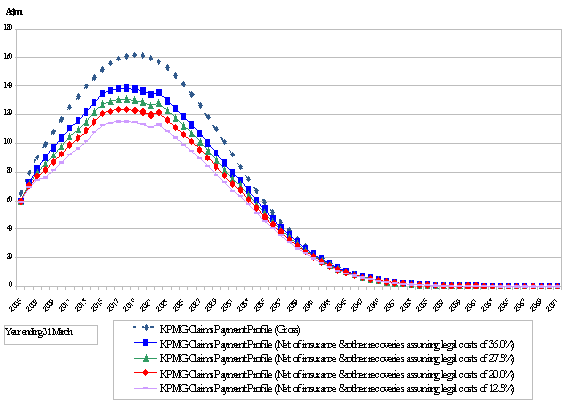
For this reason, the outcome of the recently-announced NSW Government Review of Legal Costs and
Administrative Costs in Dust Diseases Compensation Claims is expected to have a critical impact on
the long-term financial strength of the proposed Special Purpose Fund and the affordability and
sustainability of James Hardie’s funding proposal.
Timetable
The Principal Agreement contemplated by the Heads of Agreement is expected to be finalised
shortly after the outcome of the NSW Government Review is known (anticipated to be in early
5
March 2005). Whereas the Heads of Agreement is non-binding, the Principal Agreement will be a
legally binding and enforceable Agreement.
Subject to an assessment by the Board of JHINV of the affordability of the funding arrangement in
light of the likely financial impact of any proposed reforms flowing from the NSW Government
Review, and subject to receiving the support of its lenders and the findings of an independent
expert’s report (commenting on whether the voluntary funding proposal is in the interests of JHINV
shareholders), the Board intends that shareholders consider the proposal at a general meeting,
expected to be held mid-2005.
End
Media Enquiries:
James Rickards
Telephone: 61 2 8274 5304
Mobile: 0419 731 371
Email: [email protected]
Facsimile: 61 2 8274 5218
Investor and Analyst Enquiries:
Steve Ashe – Vice President, Investor Relations
Telephone: 61 2 8274 5246
Mobile: 0408 164 011
Email: [email protected]
www.jameshardie.com
Disclaimer
This Company Statement contains forward-looking statements. We may from time to time make
forward-looking statements in our periodic reports filed with the Securities and Exchange
Commission on Forms 20-F and 6-K, in our annual reports to shareholders, in offering circulars and
prospectuses, in media releases and other written materials and in oral statements made by our
officers, directors or employees to analysts, institutional investors, representatives of the media
and others. Examples of such forward-looking statements include:
| |
• |
|
Statements based on KPMG’s actuarial analysis of future claims on which we have relied; |
| |
| |
• |
|
projections of our operating results or financial condition; |
| |
| |
• |
|
statements of our plans, objectives or goals, including those relating to
competition, acquisitions, dispositions and our products; |
| |
| |
• |
|
statements about our future economic performance or that of the United States,
Australia or other countries in which we operate; and |
| |
| |
• |
|
statements about product or environmental liabilities. |
Words such as “believe,” “anticipate,” “plan,” “expect,” “intend,” “target,” “estimate,” “project,”
“predict,” “forecast,” “guideline,” “should,” “aim” and similar expressions are intended to
identify forward-looking statements but are not the exclusive means of identifying such statements.
Forward-looking statements involve inherent risks and uncertainties. We caution you that a number
of important factors could cause actual results to differ materially from the plans, objectives,
expectations, estimates and intentions expressed in such forward-looking statements. These factors
include but are not limited to: all matters relating to or arising out of the prior manufacture of
asbestos by ABN 60 and certain former subsidiaries; competition and product pricing in the markets
in which we operate; general economic and market conditions; compliance with and possible changes
in environmental and health and safety laws; the successful transition of new senior management;
the success of our research and development efforts; the supply and cost of raw materials; our
reliance on a small number of product distributors; the consequences of product failures or
defects; exposure to environmental, asbestos or other legal proceedings; risks of conducting
business internationally; compliance with and changes in tax laws and treatments; and foreign
exchange risks. We caution you that the foregoing list of factors is not exclusive and that other
risks and uncertainties may cause actual results to differ materially from those in forward-looking
statements. Forward-looking statements speak only as of the date they are made.
6
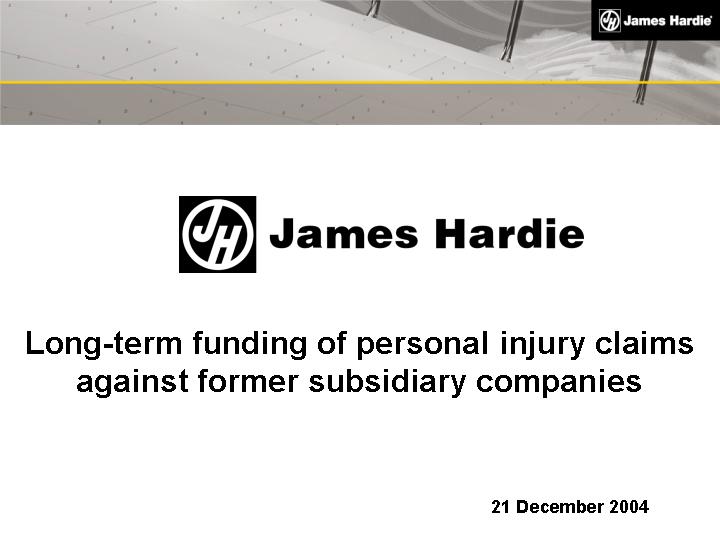
|
Long-term funding of personal injury claims
against former subsidiary companies
21 December 2004
|
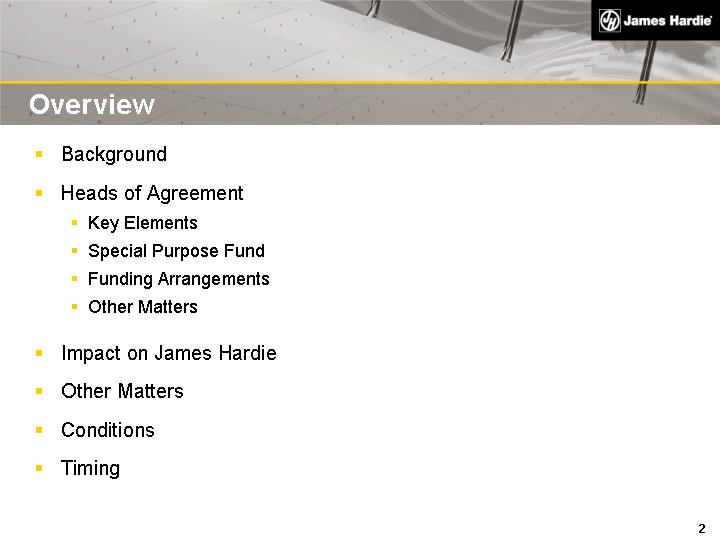
|
Overview
Background
Heads of Agreement
Key Elements
Special Purpose Fund
Funding Arrangements
Other Matters
Impact on James Hardie
Other Matters
Conditions
Timing
|
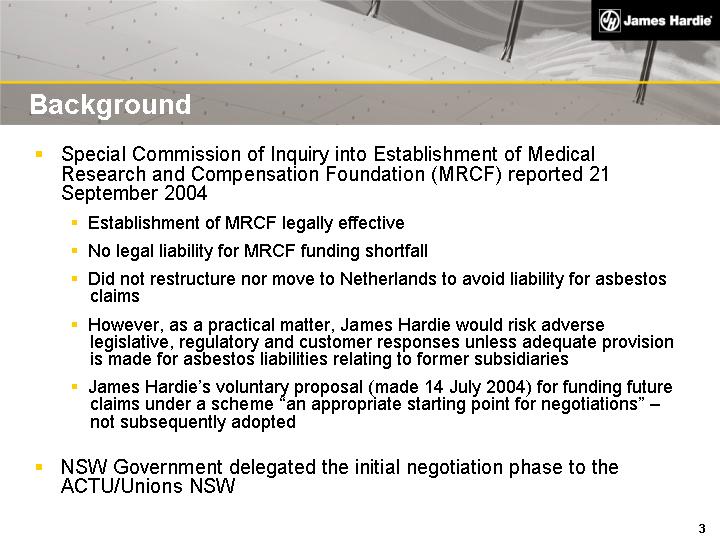
|
Background
Special Commission of Inquiry into Establishment of Medical
Research and Compensation Foundation (MRCF) reported 21
September 2004
Establishment of MRCF legally effective
No legal liability for MRCF funding shortfall
Did not restructure nor move to Netherlands to avoid liability for asbestos
claims
However, as a practical matter, James Hardie would risk adverse
legislative, regulatory and customer responses unless adequate provision
is made for asbestos liabilities relating to former subsidiaries
James Hardie's voluntary proposal (made 14 July 2004) for funding future
claims under a scheme "an appropriate starting point for negotiations" -
not subsequently adopted
NSW Government delegated the initial negotiation phase to the
ACTU/Unions NSW
|
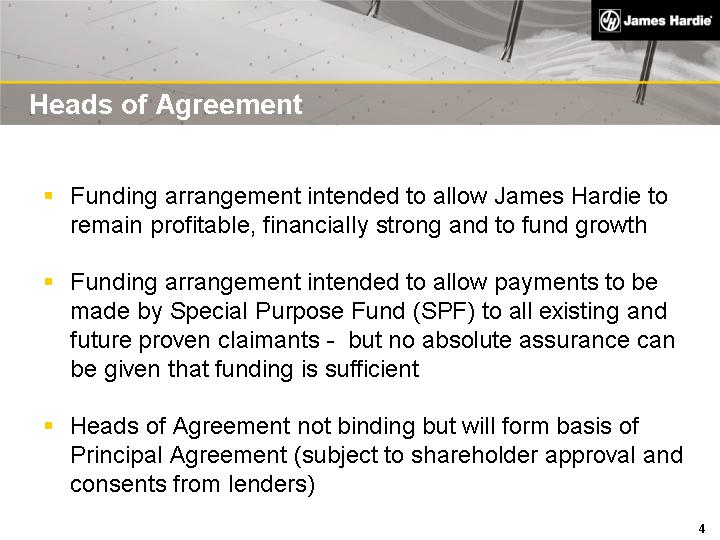
|
Heads of Agreement
Funding arrangement intended to allow James Hardie to
remain profitable, financially strong and to fund growth
Funding arrangement intended to allow payments to be
made by Special Purpose Fund (SPF) to all existing and
future proven claimants - but no absolute assurance can
be given that funding is sufficient
Heads of Agreement not binding but will form basis of
Principal Agreement (subject to shareholder approval and
consents from lenders)
|
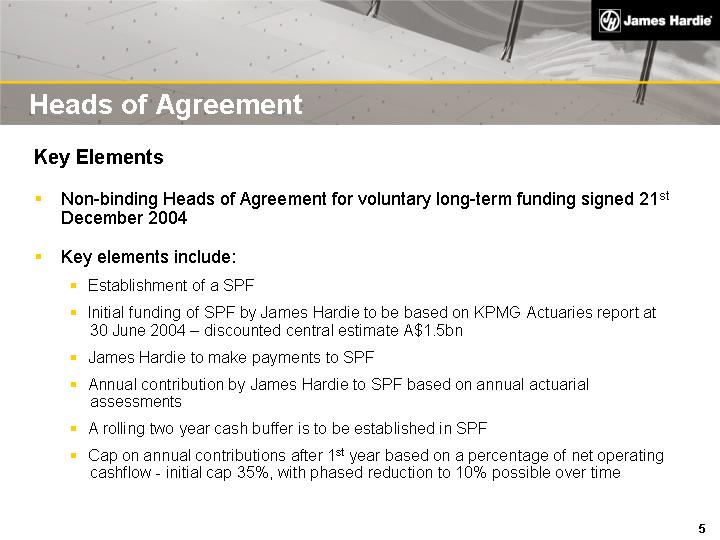
|
Heads of Agreement
Key Elements
Non-binding Heads of Agreement for voluntary long-term funding signed 21st
December 2004
Key elements include:
Establishment of a SPF
Initial funding of SPF by James Hardie to be based on KPMG Actuaries report at
30 June 2004 - discounted central estimate A$1.5bn
James Hardie to make payments to SPF
Annual contribution by James Hardie to SPF based on annual actuarial
assessments
A rolling two year cash buffer is to be established in SPF
Cap on annual contributions after 1st year based on a percentage of net operating
cashflow - initial cap 35%, with phased reduction to 10% possible over time
|
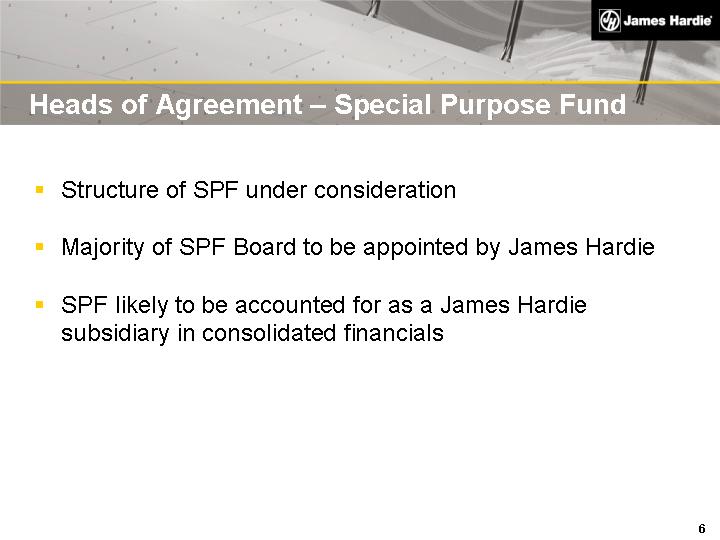
|
Heads of Agreement - Special Purpose Fund
Structure of SPF under consideration
Majority of SPF Board to be appointed by James Hardie
SPF likely to be accounted for as a James Hardie
subsidiary in consolidated financials
|
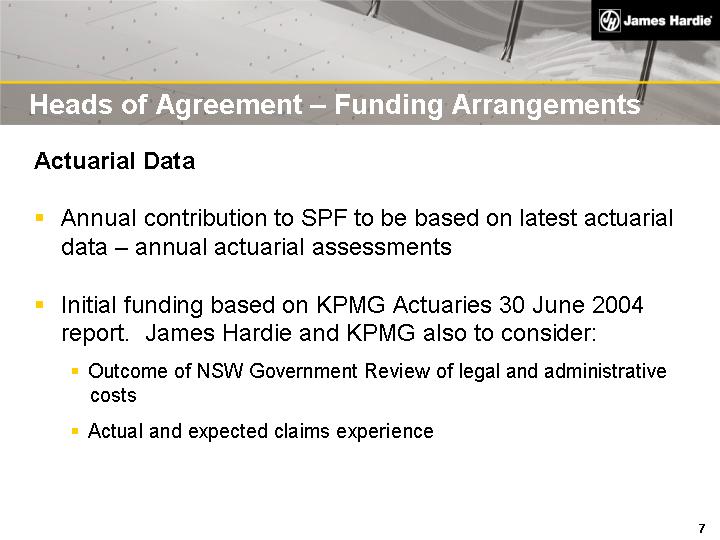
|
Heads of Agreement - Funding Arrangements
Actuarial Data
Annual contribution to SPF to be based on latest actuarial
data - annual actuarial assessments
Initial funding based on KPMG Actuaries 30 June 2004
report. James Hardie and KPMG also to consider:
Outcome of NSW Government Review of legal and administrative
costs
Actual and expected claims experience
|
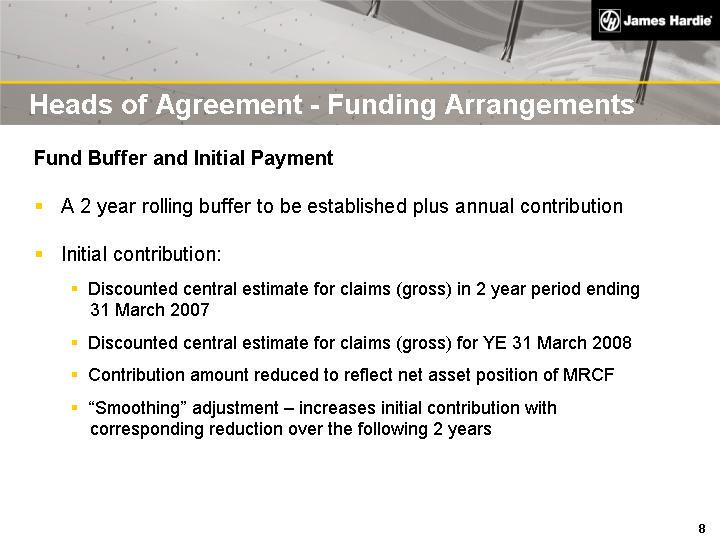
|
Heads of Agreement - Funding Arrangements
Fund Buffer and Initial Payment
A 2 year rolling buffer to be established plus annual contribution
Initial contribution:
Discounted central estimate for claims (gross) in 2 year period ending
31 March 2007
Discounted central estimate for claims (gross) for YE 31 March 2008
Contribution amount reduced to reflect net asset position of MRCF
"Smoothing" adjustment - increases initial contribution with
corresponding reduction over the following 2 years
|
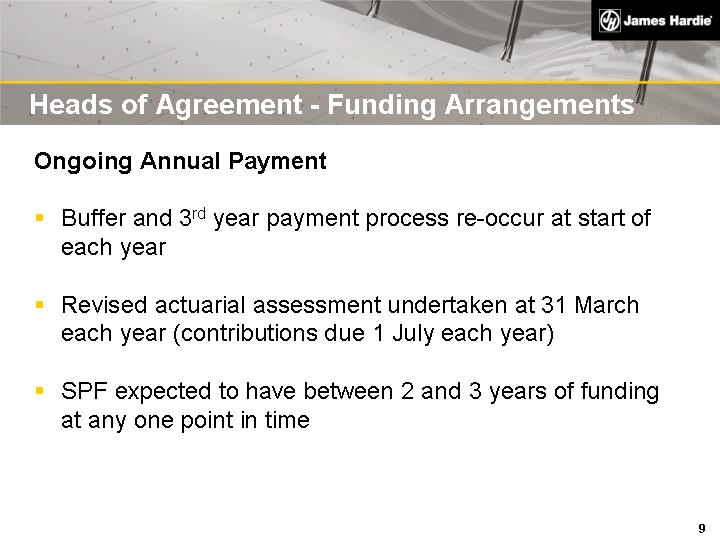
|
Heads of Agreement - Funding Arrangements
Ongoing Annual Payment
Buffer and 3rd year payment process re-occur at start of
each year
Revised actuarial assessment undertaken at 31 March
each year (contributions due 1 July each year)
SPF expected to have between 2 and 3 years of funding
at any one point in time
|
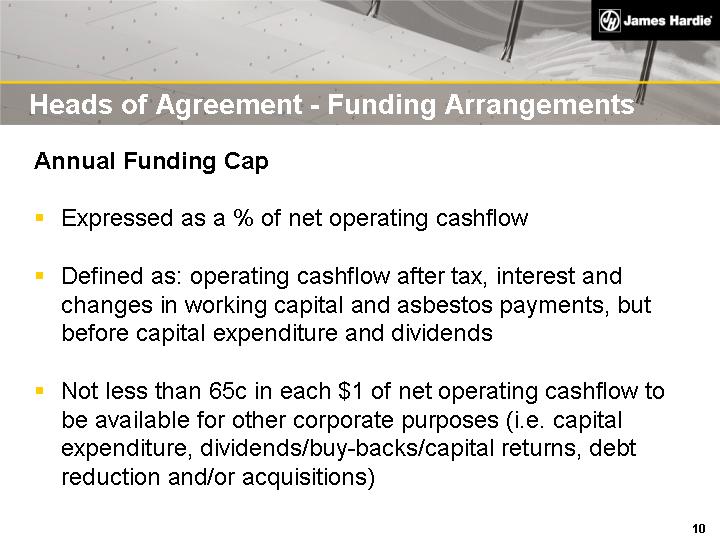
|
Heads of Agreement - Funding Arrangements
Annual Funding Cap
Expressed as a % of net operating cashflow
Defined as: operating cashflow after tax, interest and
changes in working capital and asbestos payments, but
before capital expenditure and dividends
Not less than 65c in each $1 of net operating cashflow to
be available for other corporate purposes (i.e. capital
expenditure, dividends/buy-backs/capital returns, debt
reduction and/or acquisitions)
|
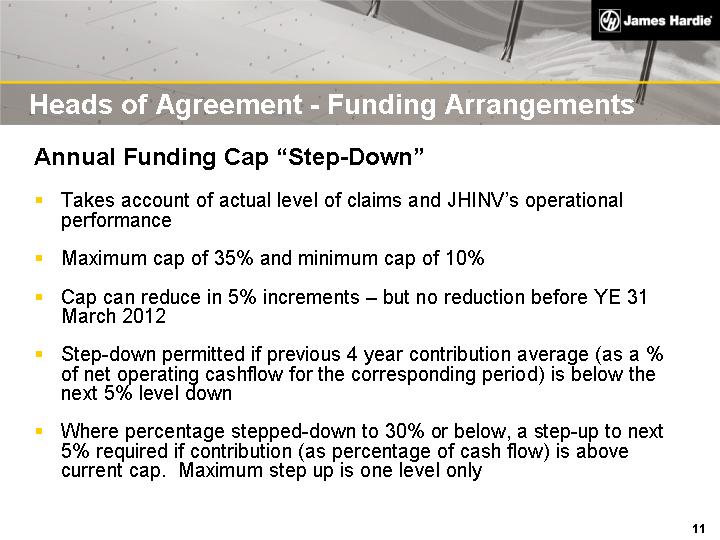
|
Heads of Agreement - Funding Arrangements
Annual Funding Cap "Step-Down"
Takes account of actual level of claims and JHINV's operational
performance
Maximum cap of 35% and minimum cap of 10%
Cap can reduce in 5% increments - but no reduction before YE 31
March 2012
Step-down permitted if previous 4 year contribution average (as a %
of net operating cashflow for the corresponding period) is below the
next 5% level down
Where percentage stepped-down to 30% or below, a step-up to next
5% required if contribution (as percentage of cash flow) is above
current cap. Maximum step up is one level only
|
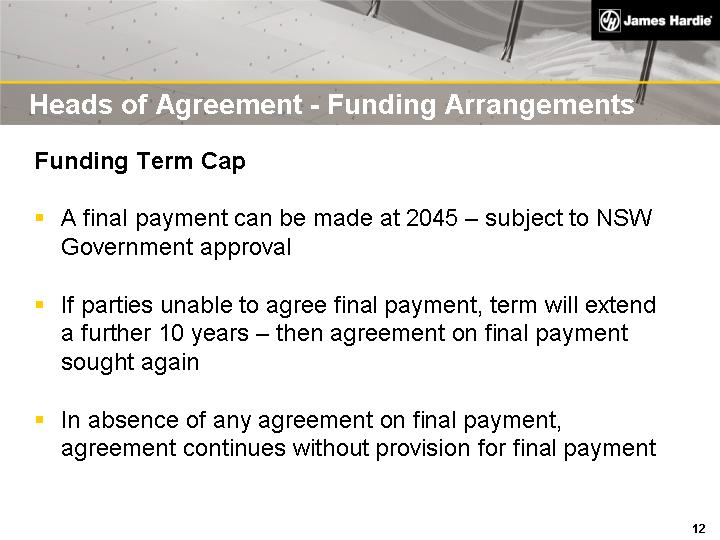
|
Heads of Agreement - Funding Arrangements
Funding Term Cap
A final payment can be made at 2045 - subject to NSW
Government approval
If parties unable to agree final payment, term will extend
a further 10 years - then agreement on final payment
sought again
In absence of any agreement on final payment,
agreement continues without provision for final payment
|
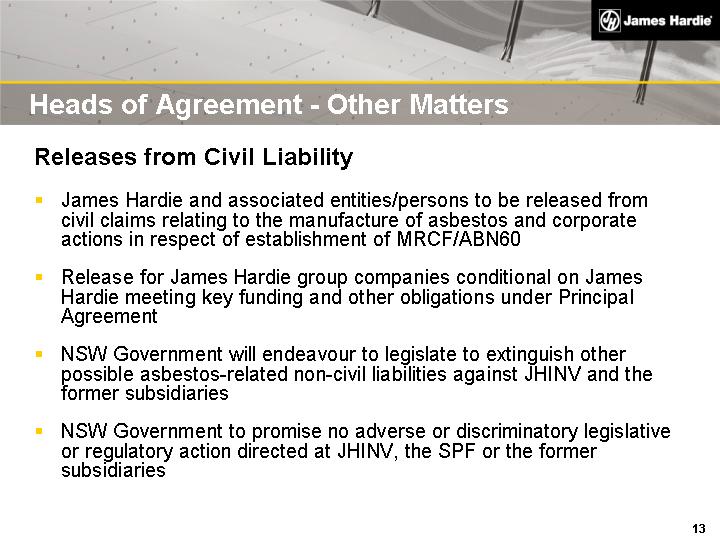
|
Heads of Agreement - Other Matters
Releases from Civil Liability
James Hardie and associated entities/persons to be released from
civil claims relating to the manufacture of asbestos and corporate
actions in respect of establishment of MRCF/ABN60
Release for James Hardie group companies conditional on James
Hardie meeting key funding and other obligations under Principal
Agreement
NSW Government will endeavour to legislate to extinguish other
possible asbestos-related non-civil liabilities against JHINV and the
former subsidiaries
NSW Government to promise no adverse or discriminatory legislative
or regulatory action directed at JHINV, the SPF or the former
subsidiaries
|
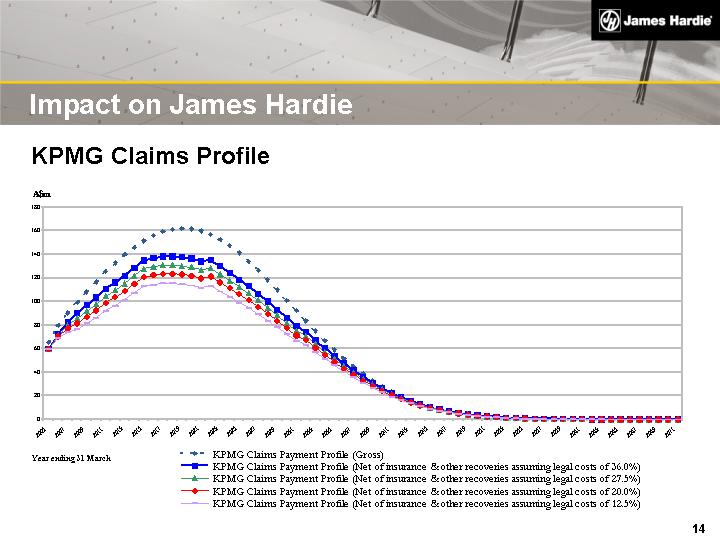
|
Impact on James Hardie
KPMG Claims Profile
0
20
40
60
80
100
120
140
160
180
2005
2007
2009
2011
2013
2015
2017
2019
2021
2023
2025
2027
2029
2031
2033
2035
2037
2039
2041
2043
2045
2047
2049
2051
2053
2055
2057
2059
2061
2063
2065
2067
2069
2071
KPMG Claims Payment Profile (Gross)
KPMG Claims Payment Profile (Net of insurance & other recoveries assuming legal costs of 36.0%)
KPMG Claims Payment Profile (Net of insurance & other recoveries assuming legal costs of 27.5%)
KPMG Claims Payment Profile (Net of insurance & other recoveries assuming legal costs of 20.0%)
KPMG Claims Payment Profile (Net of insurance & other recoveries assuming legal costs of 12.5%)
A$m
Year ending 31 March
|
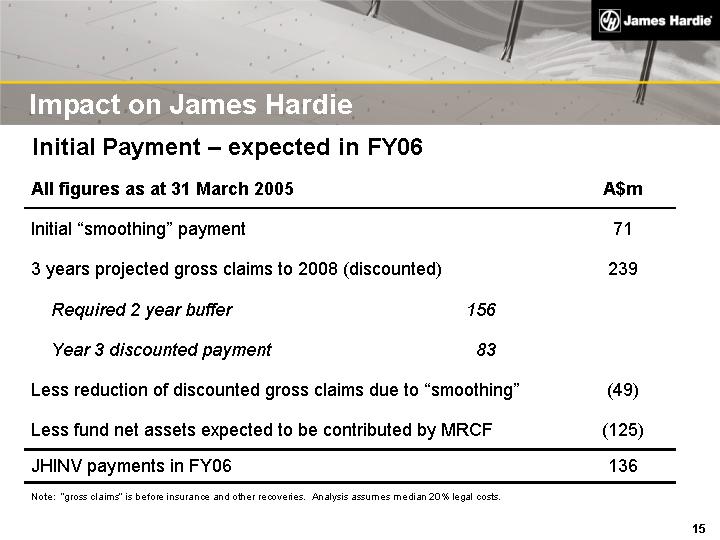
|
Impact on James Hardie
Initial Payment - expected in FY06
All figures as at 31 March 2005 A$m
Initial "smoothing" payment 71
3 years projected gross claims to 2008 (discounted) 239
Required 2 year buffer 156
Year 3 discounted payment 83
Less reduction of discounted gross claims due to "smoothing" (49)
Less fund net assets expected to be contributed by MRCF (125)
JHINV payments in FY06 136
Note: "gross claims" is before insurance and other recoveries. Analysis assumes median 20% legal costs.
|
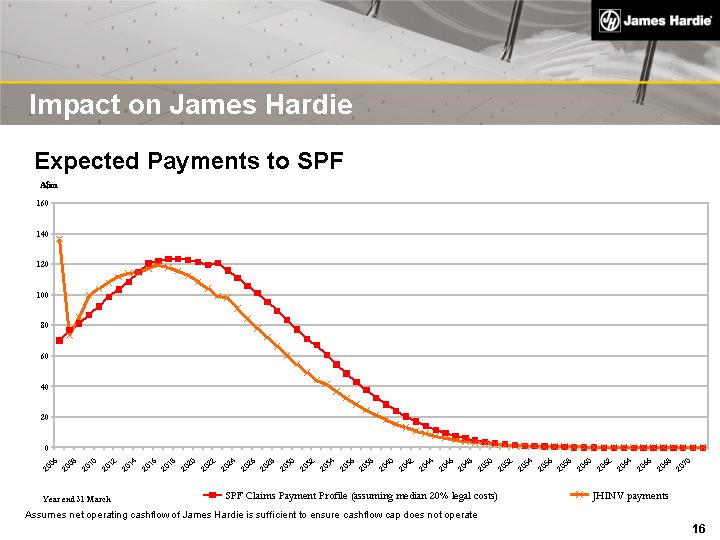
|
Impact on James Hardie
Expected Payments to SPF
Assumes net operating cashflow of James Hardie is sufficient to ensure cashflow cap does not operate
0
20
40
60
80
100
120
140
160
2006
2008
2010
2012
2014
2016
2018
2020
2022
2024
2026
2028
2030
2032
2034
2036
2038
2040
2042
2044
2046
2048
2050
2052
2054
2056
2058
2060
2062
2064
2066
2068
2070
SPF Claims Payment Profile (assuming median 20% legal costs)
JHINV payments
A$m
Year end 31 March
|
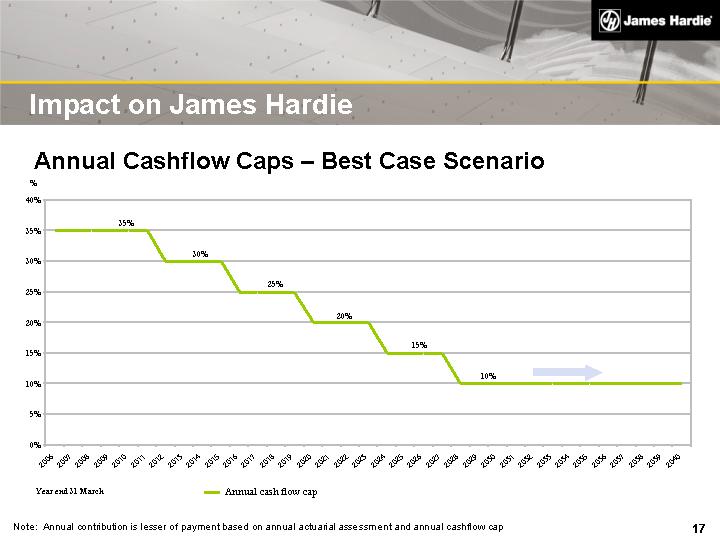
|
Impact on James Hardie
Annual Cashflow Caps - Best Case Scenario
Note: Annual contribution is lesser of payment based on annual actuarial assessment and annual cashflow cap
0%
5%
10%
15%
20%
25%
30%
35%
40%
2006
2007
2008
2009
2010
2011
2012
2013
2014
2015
2016
2017
2018
2019
2020
2021
2022
2023
2024
2025
2026
2027
2028
2029
2030
2031
2032
2033
2034
2035
2036
2037
2038
2039
2040
Annual cash flow cap
35%
30%
25%
20%
15%
10%
%
Year end 31 March
|
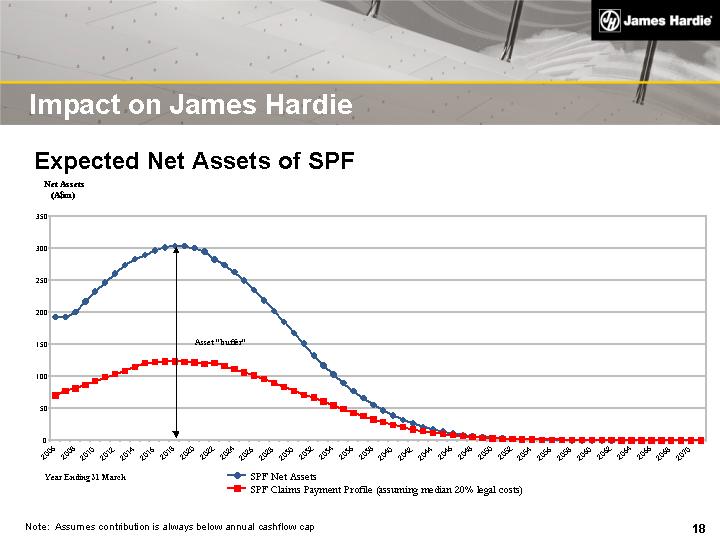
|
Impact on James Hardie
Expected Net Assets of SPF
Note: Assumes contribution is always below annual cashflow cap
0
50
100
150
200
250
300
350
2006
2008
2010
2012
2014
2016
2018
2020
2022
2024
2026
2028
2030
2032
2034
2036
2038
2040
2042
2044
2046
2048
2050
2052
2054
2056
2058
2060
2062
2064
2066
2068
2070
SPF Net Assets
SPF Claims Payment Profile (assuming median 20% legal costs)
Net Assets
(A$m)
Year Ending 31 March
Asset "buffer"
|
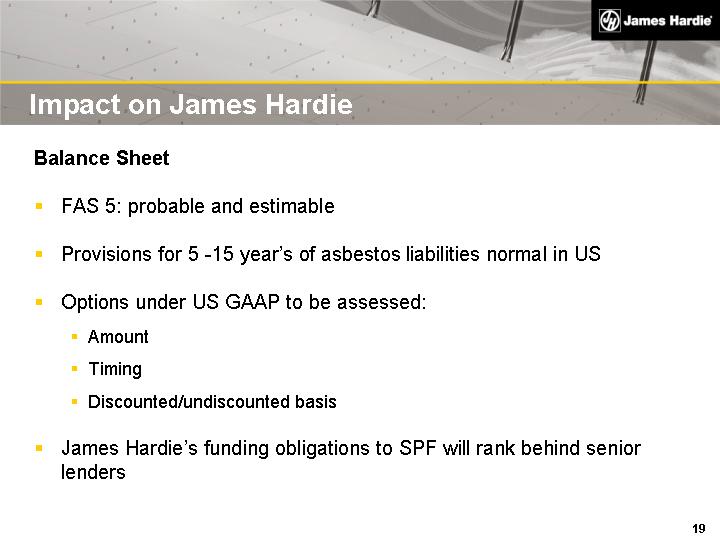
|
Impact on James Hardie
Balance Sheet
FAS 5: probable and estimable
Provisions for 5 -15 year's of asbestos liabilities normal in US
Options under US GAAP to be assessed:
Amount
Timing
Discounted/undiscounted basis
James Hardie's funding obligations to SPF will rank behind senior
lenders
|
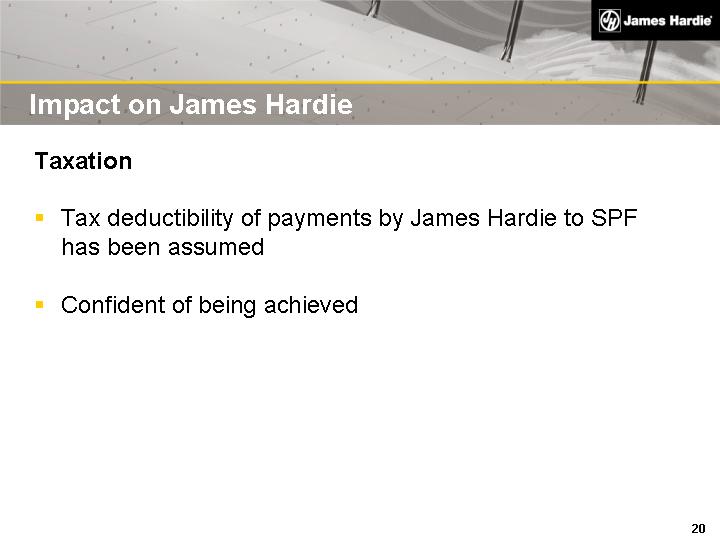
|
Impact on James Hardie
Taxation
Tax deductibility of payments by James Hardie to SPF
has been assumed
Confident of being achieved
|
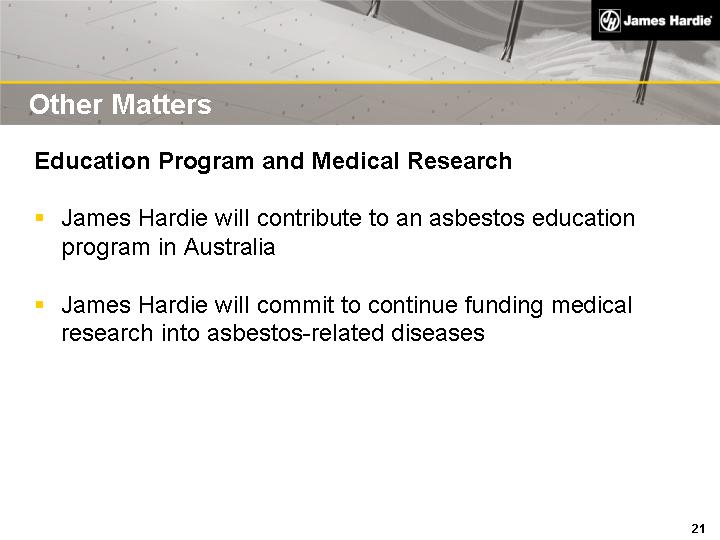
|
Other Matters
Education Program and Medical Research
James Hardie will contribute to an asbestos education
program in Australia
James Hardie will commit to continue funding medical
research into asbestos-related diseases
|

|
Conditions
The voluntary long-term funding agreement is subject to:
Completion and implementation of NSW Government Review of
legal and administrative costs
The NSW Government to provide legislative change to adopt
efficiencies and facilitate implementation of agreement
JHINV Board determination that final agreement is in JHINV's
interests
Receipt of an independent expert's report confirming the proposal
Approval of lenders to JHINV
JHINV shareholder approval
|
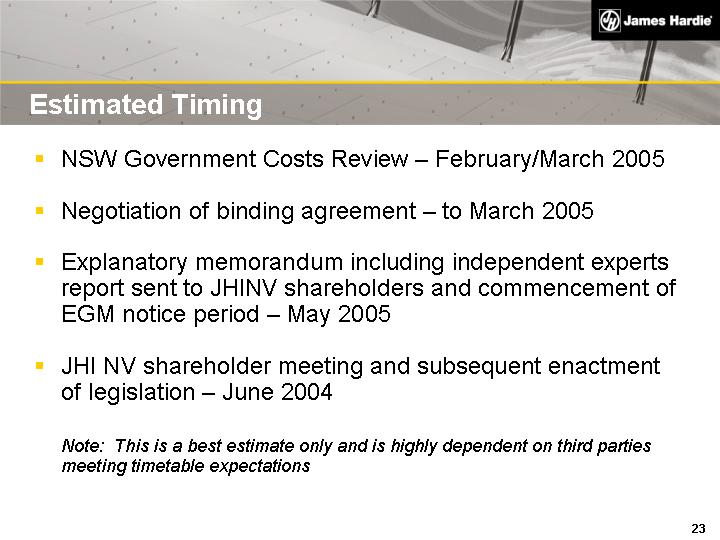
|
Estimated Timing
NSW Government Costs Review - February/March 2005
Negotiation of binding agreement - to March 2005
Explanatory memorandum including independent experts
report sent to JHINV shareholders and commencement of
EGM notice period - May 2005
JHI NV shareholder meeting and subsequent enactment
of legislation - June 2004
Note: This is a best estimate only and is highly dependent on third parties
meeting timetable expectations
|
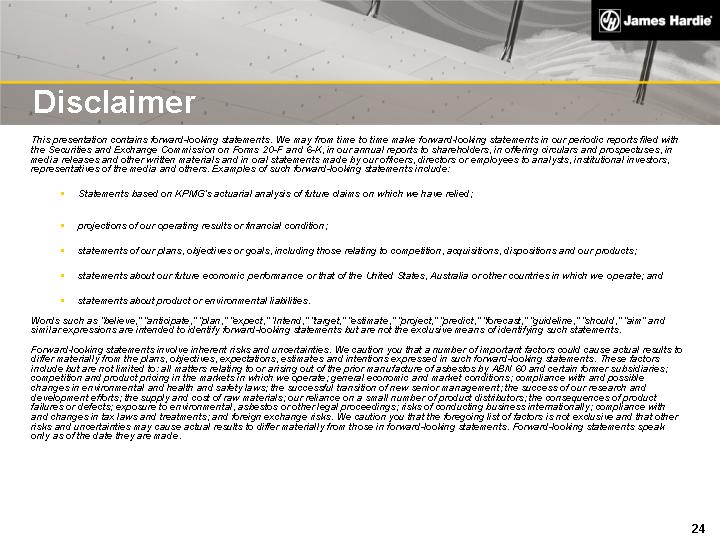
|
Disclaimer
This presentation contains forward-looking statements. We may from time to time make forward-looking statements in our periodic reports filed with
the Securities and Exchange Commission on Forms 20-F and 6-K, in our annual reports to shareholders, in offering circulars and prospectuses, in
media releases and other written materials and in oral statements made by our officers, directors or employees to analysts, institutional investors,
representatives of the media and others. Examples of such forward-looking statements include:
Statements based on KPMG's actuarial analysis of future claims on which we have relied;
projections of our operating results or financial condition;
statements of our plans, objectives or goals, including those relating to competition, acquisitions, dispositions and our products;
statements about our future economic performance or that of the United States, Australia or other countries in which we operate; and
statements about product or environmental liabilities.
Words such as "believe," "anticipate," "plan," "expect," "intend," "target," "estimate," "project," "predict," "forecast," "guideline," "should," "aim" and
similar expressions are intended to identify forward-looking statements but are not the exclusive means of identifying such statements.
Forward-looking statements involve inherent risks and uncertainties. We caution you that a number of important factors could cause actual results to
differ materially from the plans, objectives, expectations, estimates and intentions expressed in such forward-looking statements. These factors
include but are not limited to: all matters relating to or arising out of the prior manufacture of asbestos by ABN 60 and certain former subsidiaries;
competition and product pricing in the markets in which we operate; general economic and market conditions; compliance with and possible
changes in environmental and health and safety laws; the successful transition of new senior management; the success of our research and
development efforts; the supply and cost of raw materials; our reliance on a small number of product distributors; the consequences of product
failures or defects; exposure to environmental, asbestos or other legal proceedings; risks of conducting business internationally; compliance with
and changes in tax laws and treatments; and foreign exchange risks. We caution you that the foregoing list of factors is not exclusive and that other
risks and uncertainties may cause actual results to differ materially from those in forward-looking statements. Forward-looking statements speak
only as of the date they are made.
|
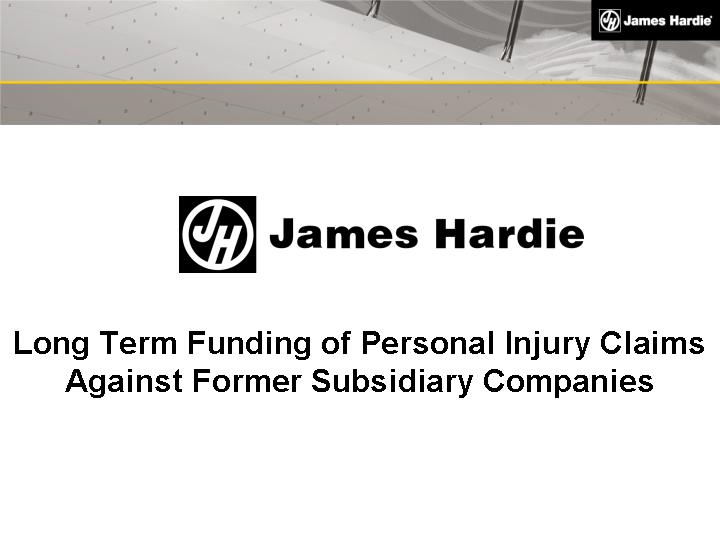
|
Long Term Funding of Personal Injury Claims
Against Former Subsidiary Companies
|


























